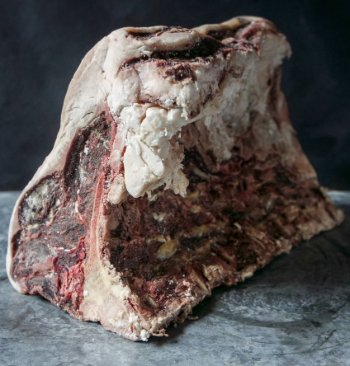Can you do it? Yes. Is it simple? Yes, and no.
What is dry aging?
Dry aging is a post mortem treatment for beef designed primarily to intensify flavour, with a secondary benefit of promoting tenderness. The flavour development is shaped by both a reduction in moisture which correlates to a concentration of flavour, and the cultivation of 'goog' mould and bacteria to lend a funky, nutty profile to the meat. In short - dry aging makes beef taste really, really good.
CAVEAT: dry aging does not appeal to everyone. There are some folks who prefer regular beef, and who find the intense and nutty flavours of dry aging too much for their palate. The assumption here is, if you've arrived at this article interested enough in creating a set up, that you enjoy aged beef. If you haven't yet tried it, it's thoroughly recommended getting in touch with a local purveyor (be it butcher or restaurant) and tasting aged beef before you embark on this journey.
What kind of steak can you dry age?
You should not age individually cut steaks. Technically speaking you can, but it's a colossal waste, as your meat will shrink vastly in size as it loses water through the aging process. When you combine the amount of rind trimming that needs to occur along with the smaller size, you'll be left with barely a sliver of steak.
What you should be dry aging are subprimals - or large whole muscles. For example, a strip of loin (bone in), or a 107/109 rib (basically a giant slab of bone in ribeye). You want to look for meat that is on the bone, not because it taste better, but because you can cut the bone away during trimming and not lose any meat.
The quality of the meat also matters. You need to use meat with a minimum degree of marbling, Choice grade or higher, and steer clear from overly-lean cuts (like the round). Lean or lower grade meat does not develop any significant intensification of flavour, because the marbling is slight.
How long should you age meat for?
The length of time you leave meat to age depends on numerous factors. What cut are you using? What kind of mould do you have in your fridge? Is it more intense than other strains? How much of that mould is there?
Generally, it takes at least 30 days before you can start to taste any signature dry ages flavours. A good average is somewhere between 60-80 days. After a certain point, dry aged steak turns from a delight to a delicacy. Meaning; the funkier it gets, the few people it will appeal to. You also have to consider the loss versus gain. The more you leave the meat to age, the thicker and tougher the rind will be, ergo the more you will need to cut away.
The dry aging set up
This article here provides a great overview of equipment needed and things to consider when creating a dry aging environment.
Food safety
When you sear a steak, the surface area comes into contact with high heat which kills off any bacteria. The middle of the steak is safe to keep rare, as it's sterile, and has never been exposed to said bacteria.
So this is where the bone comes into play. Given its shape and rigidity, not all of it will come into direct contact with the heat source. Further, It's highly unlikely that the heat is going to reach the porous and hollow bone interior and heat it to a safe temperature of 74 degrees C. Basically, the bone is going to remain a fairground for bacteria and mould. If you want to serve your steak with the bone, cut the bone away, cook your steak as normal, throw the bone into a hot oven to roast (which will make it taste better when gnawed anyway) and serve together.
For all food safety requirements surrounding dry aging meat in Australia click here.
If you are looking for an online butcher Melbourne then look no further.
We are one of the top meat suppliers Melbourne
Looking to have your meat delivery melbourne
Talk to our team at University Meat
 © 2016 University Meat |
© 2016 University Meat |







